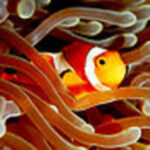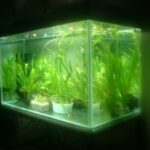Aquarium lighting has made dramatic improvements in recent years. The days of standard fluorescent lighting that provided little by way of full spectrum rays and intensity have long been a thing of the past. The invention of more effective and beneficial lighting like VHO and power compact light fixtures quickly moved into the limelight. Then, as quickly as they appeared, they phased out just as fast, similar to the prehistoric eight track tape player craze back in the mid 70’s. In favor of more efficient and powerful lighting, metal halide and T-5 technology was developed. During this time, there was no looking back and hobbyiests were not thinking ahead with any kind of vision either, that any other light form could rival these superior light sources due to the dramatic improvements and benefits associated with these products. I guess it was inevitable, that T-5 and metal halide lighting advancements would, eventually, succumb to a new technological juggernaut. Enter, LED or light emitting diode lighting technlogy to the saltwater aquarium hobby, with all its furry.
Oh, what wondrous benefits and results can be attained with LED lighting schemes. Let’s take a look at some of the benefits of implementing LED lighting into a saltwater aquarium.
Cost is a big concern to many aquarist. The initial cost of LED light fixtures is really the only drawback with this type of lighting. Having said this, the price of LED lighting has subsided greatly over the past five years or so. It is now possible to buy an efficient and effective LED pendant fixture for under $300 now, which would have run you almost twice as much, five years ago.
How about energy consumption costs. LED fixtures consume roughly half of what a standard fluorescent fixture would cost you on your energy bill each month for comparable watt output. Then factor in the heat issue of many high output lighting units. LED bulbs burn very cool, lessening the need to run a chiller to maintain optimal water temperatures. Then their is the issue of bulb replacement costs. Many bulbs cost anywhere from $40.00-$100.00 and up per replacement bulb. These bulbs also need to be replaced at least once a year as well. LED bulbs have a life expectancy of 10 to 12 years before replacing the unit. Do the math and you will find out that LED lighting over the long run will more than cover the initial price and then some making this lighting style very cost effective.
As far as PUR and PAR are concerned, a standard LED light pendant is comparable to a 250 watt halide unit. The high output LED units are similar to that of light generated by a 400 watt halide. LED’s really give you a bang for the buck.
Taking this a step further and you can select a LED unit such as that made by Acan or Radion that enable you to do all sorts of neat things with it. From allowing you to set these units up on a timer, to being able to dim the lights at various intervals, to being able to actually choose which color LED bulbs you wish to you at any given time as well as how much of a particular bulb color, from full intensity to subdued color. This enables you to more realistically mimic the suns spectral intensity while being able to create cloud cover scenario, which is cool since very rarely is their full intense sunlight over the reefs of the world day in and day out.
Instead of just having standard 10,000k, 20,000k, 6700k, 14,000k and actinic light, with LED lighting you can be creative as far as what color scheme you wish to employ at any given time. Maybe you want to use red, green and blue together, or white and blue, or just blue or green. What choices you have at your fingertips to program any color combination you desire and control the intensity of these colors through a controller to boot.
As far as being able maintain and grow any type of coral, Tridacna Clams, algae, sponges, tunicates and gorgonians, with LED,s the sky is the limit, plus these lights provide the same shimmer lines that are normally associated with metal halide bulbs. It is said that the shimmer lines are beneficial and similar to those encountered in the natural reefs as the suns ray penetrate through the water and the waves that act like a magnifying glass piercing the corals with higher than normal rays from the sun on a calm day.
I have had a myriad of lighting fixtures over the course of the many years being in the marine hobby. From standard fluorescents, to halides and t-5 bulbs, only to be drawn into the world of the new technological innovation in aquarium lighting, that being LED. I can say, honestly, that these LED lights rock as I have been able to not only maintain the gamut of corals available from novice to delicate, but see them grow consistently and the colors are as vibrant as can be.
If at all, I hope to have been able to spark your attention and atleast give you some honest advice and knowledge regarding this new found lighting craze that is taking the hobby by storm. Do yourself and your aquarium a favor, by atleast look into LED lighting and all that it has to offer you and the inhabitants within your replica of one of lifes greatest creation, the undersea world teeming with life, color, diversity and fascination. You won’t be disappointed, I promise you!




